Foresights and ideas that expand minds and inspire a change of heart.
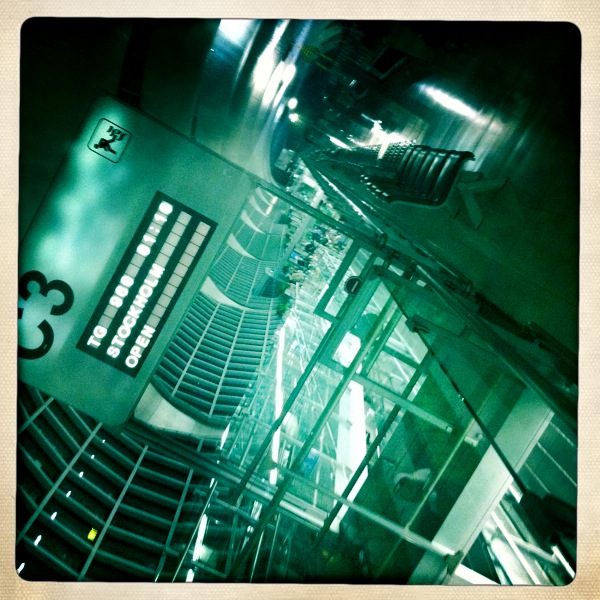
Shanghai-Beijing High Speed Train - the Future of Personal Connection in Business?
*This is an excerpt from an article I recently wrote for the Shanghai-Beijing High Speed Train Business Travellers Magazine. It has been adapted back to English.
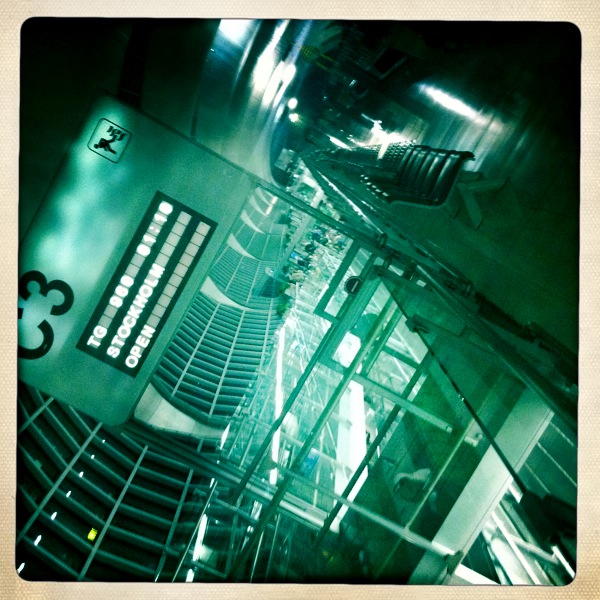
It is perhaps ironic that I am writing this sentence as the Scottish countryside is rushing past me on the East Coast railtracks on my way from London to the Scottish capital. Excitedly bound for the TEDGlobal Conference in this centre for the European Enlightenment to discuss, debate, and think about the future of technology, entertainment and design, the Angus beef that lazily glance up at my vacuous ponderings really couldn’t care less. It’s ironic, because this event gathers many of the world’s thought leaders in a physical intellectual mardi gras of sorts. Personally, I have travelled via air from Sydney, via Bangkok and London, to the Balmoral Hotel in the shadows of Edinburgh Castle. It’s a face-to-face extravaganza and coming together of ideas, entrepreneurs, philosophers, and futurists, which facilitates thought on how digital media, technology and design may make these kinds of physical and geographic-specific rendezvouses defunct in the future.
Big ideas are still best shared in the company of good friends. Or? While enjoying a farm-to-table lunch in the company of a Dutch Museum futurist, a New York media lawyer, and a Canadian interface designer in an 16th century old Scottish castle, we shared an intellectual diet of ideas on sustainable cities in China, glocalisation, urban farming practices in Brooklyn, the carbon footprint of Sushi, and Facebook vanity. While we are interconnected, hyperlinked, and linkedin 24/7/365 these days, a computer interface still cannot fully replace a human face. While we all like to think global, we still act local. While we all like to communicate digitally, we still like to kiss and connect analogue. 2nd Life might seem attractive, but business still happens in 1st life. Nobody remembers their first mp3 download, but vinyl is forever.
Nothwithstanding technological advancements, we still crave the analogue, the tangible, the physical form. While more 2-5 year-olds know how to play Angry Birds on their iPhones than know how to tie their shoelaces today according to research, the iRevolution indicates that digital and analogue may be merging - think of the inherent meaning in the name iPod Touch. We may still recall the good old days when a tweet was just a sound that a bird made, when a blackberry was just a fruit, and when we didn't have to feel so dumb with a smart phone. Things were kind of simpler back then.
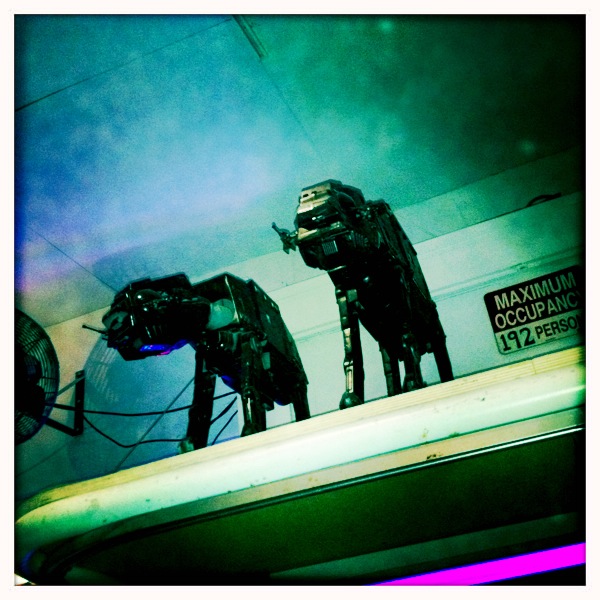
We are at a generational and behavioural cross-roads when it comes to tomorrow’s personal connection in business. Generation Z (born between 1994-2010) have never known a world without the internet. If you thought Generation Y, Mao’s Little Emperors (born 1979 - 1994) were weird, how odd will Generation Z be? Generation Y learnt to ‘speak‘ technology as teenagers, and are extremely capable using devices which for them have been social, rather than business, tools first and foremost. Generation Z learnt technology natively as their mother tongue and ‘speak’ it without an accent. While older generations insist on face-to-face meetings, physical leadership retreats, and ‘wining and dining’ clients, Generation Z are as comfortable collaborating in World of Warcraft, as they are in personally branding themselves on Renren. The question to ask yourself as a business leader is ‘how would my children run this organisation differently?’. It is likely that they would set up internal social networks for knowledge management and collaboration to break down silos, create 3D ‘Avatar’ style environments for meetings and demonstrations, and leadership simulations drawn from virtual science fiction scenarios.
In the future it will be critical to be equally able to connect personally via digital devices as in analogue life. Cisco predicts that by 2014, 90% of all content on-line will be video. Video is less forgiving than words, so for future-minded businesses to prosper, it will be critical for leaders to connect with both a broader audience capably and inspirationally via on-line video as well as via video presence. One of my clients has cut travel costs by 80% by using video presence and teleconferencing for their meetings, and instead focussing their face-to-face meetings on important trust and relationship building activities like scenario planning, golf, sailing and team building. When you meet in person, you need to make it count. We need to question the need to meet face-to-face in inane and menial meetings - meetings which can be more effectively managed on-line via video. The added benefit of personal connection via a computer interface for certain meetings is that people tend to come more prepared, and are trained to ‘think before you speak’, which boosts output and ensures that meetings are to the point, vis-a-vis the regular Monday morning meetings.
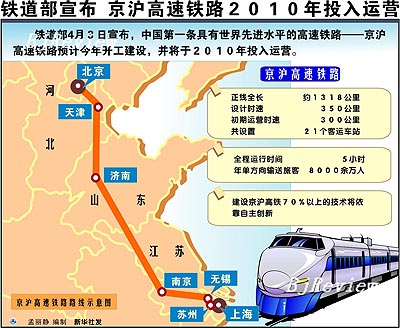
So how does this impact business travel? Work hours are likely to become even more assymetrical, which will further shift the way we work. The old notion of working a certain number of hours in a certain place is likely to be retired as glocalization drives us to connect across time-zones to an even further extent. At the consumer electronics retailer Best Buy, business units which have implemented the ROWE (Results Only Work Environment) have seen productivity increase by an average of 39%. This largely removes the need for physical presence in a geographic location, and instead focusses on ‘getting the job done’, whatever, and whenever a solution is required. Therefore it is interesting to case study next practice work environments like Google and Macquarie Bank, where solitary work spots, communal desks, cross-fertilising idea cafes, and telecommuting are becoming the norm. This flexibility recognises the different types of thinking, preferences and communication strengths of key staff members. While networks and spontaneous meetings are still at the core of these systems, these initiatives move organisation into a virtual direction, where there is more focus on the resulting innovations and outputs, than the process of getting there.
At the same time, high speed rail, collaborative car sharing, and more efficient air travel is likely to change fundamentally how we perceive of travel. In some ways we may actually speed up our productivity, creativity and innovation by slowing down. We are likely to see a counter-intuitive return to the romance of travel as a result of being contstantly connected. We may choose to spend time on high speed trains, not just as a result of convenience, but as a lower stress option comapred to the archaic and badly designed airports.Thus, the interstate or international travel may become less of a commute, and more of an experience. In many ways, the journey may become the destination - a shared meeting space with trusted colleagues, where private reflections, insights and ideas can be shared and built on. We may choose travel options not just based on efficiency and speed, but the kind of experience and environment we are seeking for our business leaders, and the kind of output we are hoping for.
In the future, we need to consider how to think global, yet act local. We need to communicate digitally, but also connect in an analogue fashion with the key stakeholders around us that matter and move business forward. A simple XY model can illustrate some initiatives you may consider as you map how your leaders and organisation will connect with clients and staff over the coming years (feel free to add your own).
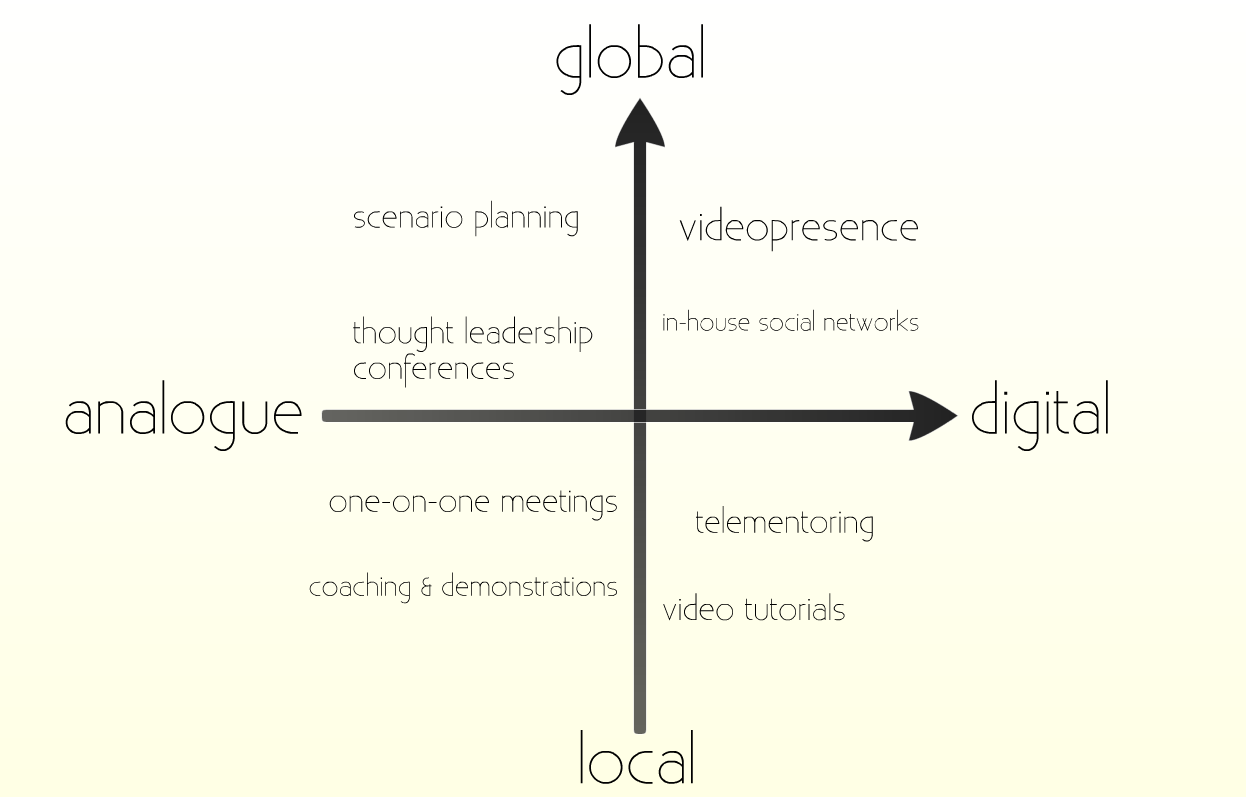
In a burst of paradox, and with the delayed on-set of the rocking motions of an old British train, I find myself in the high tech, digital environs of the TEDGlobal simulcast space. In this parallel space 2 floors below the main conference stage, innovators are connecting back to home globally to 73 countries via digital devices while still interacting personally over coffee and engaging both physically and virtually with technological demonstrations that are likely to upend the way we do business over the next 10 years. This is the blend of global/local and digital/analogue we need to get used to and we, and we need to enable our leaders to upgrade the way they connect with clients and staff in new ways. That way you ensure that you stay compatible and ‘on track’ with the future.
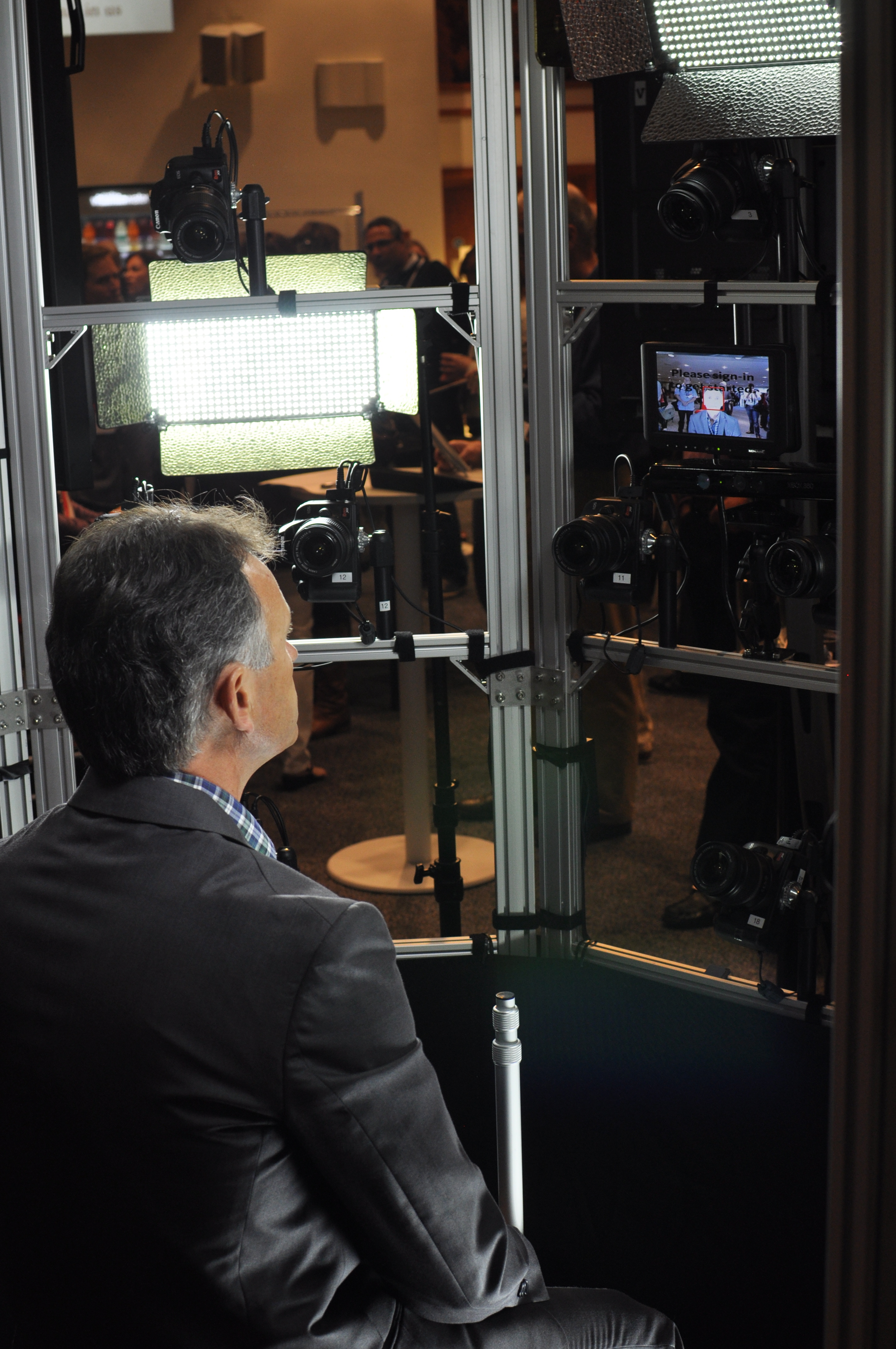
Anders Sorman-Nilsson is a reformed lawyer, keynote speaker, and the founder and creative director of the Sydney and Stockholm based research company - Thinque. His unique global perspectives have been helping leaders, teams, and business owners in the USA, Europe, Asia and Australia make sense of and harness disruptive trends in innovations, generations and communications. His misfit insights have recently been manifested in his book Thinque Funky: Upgrade Your Thinking and amplified by endorsements via AFR Boss Magazine, Wired (UK), and Monocle.
Advising clients like Apple, MTV, Johnson & Johnson, Eli Lilly, SAP, McCann Erickson, CPA Australia, UTS Business School and Macquarie Bank on ‘next practice’, Anders’ future thinking provides GPS directions for businesses, teams and leaders seeking to navigate a constantly shifting business landscape, and successfully enter a new decade of thinking. He is an active member of TEDGlobal and one of 25 accredited Thought Leaders mentors in the world.
For more information, visit the Thinque Tank blog on www.thinque.com.au/blog

Header Text
Lorem ipsum dolor sit amet, consectetur adipiscing elit, sed do eiusmod tempor incididunt ut labore et dolore magna aliqua. Ut enim ad minim veniam, quis nostrud exercitation ullamco laboris nisi ut aliquip ex ea commodo consequat. Duis aute irure dolor in reprehenderit in voluptate velit esse cillum dolore eu fugiat nulla pariatur.
Lorem ipsum dolor sit amet, consectetur adipiscing elit, sed do eiusmod tempor incididunt ut labore et dolore magna aliqua. Ut enim ad minim veniam, quis nostrud exercitation ullamco laboris nisi ut aliquip ex ea commodo consequat. Duis aute irure dolor in reprehenderit in voluptate velit esse cillum dolore eu fugiat nulla pariatur.
Lorem ipsum dolor sit amet, consectetur adipiscing elit, sed do eiusmod tempor incididunt ut labore et dolore magna aliqua. Ut enim ad minim veniam, quis nostrud exercitation ullamco laboris nisi ut aliquip ex ea commodo consequat. Duis aute irure dolor in reprehenderit in voluptate velit esse cillum dolore eu fugiat nulla pariatur.

Header Text
Lorem ipsum dolor sit amet, consectetur adipiscing elit, sed do eiusmod tempor incididunt ut labore et dolore magna aliqua. Ut enim ad minim veniam, quis nostrud exercitation ullamco laboris nisi ut aliquip ex ea commodo consequat. Duis aute irure dolor in reprehenderit in voluptate velit esse cillum dolore eu fugiat nulla pariatur.
Lorem ipsum dolor sit amet, consectetur adipiscing elit, sed do eiusmod tempor incididunt ut labore et dolore magna aliqua. Ut enim ad minim veniam, quis nostrud exercitation ullamco laboris nisi ut aliquip ex ea commodo consequat. Duis aute irure dolor in reprehenderit in voluptate velit esse cillum dolore eu fugiat nulla pariatur.
Lorem ipsum dolor sit amet, consectetur adipiscing elit, sed do eiusmod tempor incididunt ut labore et dolore magna aliqua. Ut enim ad minim veniam, quis nostrud exercitation ullamco laboris nisi ut aliquip ex ea commodo consequat. Duis aute irure dolor in reprehenderit in voluptate velit esse cillum dolore eu fugiat nulla pariatur.

Header Text
Lorem ipsum dolor sit amet, consectetur adipiscing elit, sed do eiusmod tempor incididunt ut labore et dolore magna aliqua. Ut enim ad minim veniam, quis nostrud exercitation ullamco laboris nisi ut aliquip ex ea commodo consequat. Duis aute irure dolor in reprehenderit in voluptate velit esse cillum dolore eu fugiat nulla pariatur.
Lorem ipsum dolor sit amet, consectetur adipiscing elit, sed do eiusmod tempor incididunt ut labore et dolore magna aliqua. Ut enim ad minim veniam, quis nostrud exercitation ullamco laboris nisi ut aliquip ex ea commodo consequat. Duis aute irure dolor in reprehenderit in voluptate velit esse cillum dolore eu fugiat nulla pariatur.
Lorem ipsum dolor sit amet, consectetur adipiscing elit, sed do eiusmod tempor incididunt ut labore et dolore magna aliqua. Ut enim ad minim veniam, quis nostrud exercitation ullamco laboris nisi ut aliquip ex ea commodo consequat. Duis aute irure dolor in reprehenderit in voluptate velit esse cillum dolore eu fugiat nulla pariatur.
& STAY UP TO DATE WITH FORESIGHTS AND TREND REPORTS!
WE WILL EQUIP YOU WITH THE VIDEOS AND MATERIALS YOU NEED TO SUCCESSFULLY PITCH ASN.
0 Comment